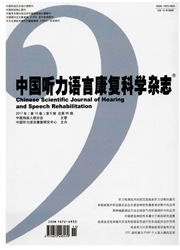

 中文摘要:
中文摘要:
目的:本研究通过总结中国感音神经性耳聋患者的致病因素,对同时携带两个基因双位点突变而导致耳聋的病例进行分析研究。方法回顾性分析4000例感音神经性耳聋患者基因突变情况,总结同时携带两个基因双位点突变而导致耳聋的病例,分析致病基因和听力表型,评估此类家庭的遗传风险。结果在4000例感音神经性耳聋患者中,发现2例耳聋患者同时携带两个基因的双位点突变。其中1例为大前庭水管综合征患者,携带SLC26A4基因的c.1229C>T(p.T410M)/c.1079C>T(p.A360V)复合杂合突变,同时携带GJB2基因c.257C>G(p.T86R)/c.299_300delAT复合杂合突变。1例患者携带GJB2基因c.235delC纯合突变,同时为线粒体DNA12S rRNA A1555G均质突变。结论对于常染色体双隐性基因双位点突变的患者,其父母再生育耳聋后代的风险将从传统的25%上升为43.75%;同时携带线粒体基因突变的耳聋患者,其母系成员则会同时携带线粒体基因突变。本研究揭示了遗传病因的复杂性。
 英文摘要:
英文摘要:
Objective Sensorineural hearing loss was reported as a single-gene disease by most studies. Here we reported two cases with pathogenic patterns in different genes.Methods 4000 patients of sensorineural hearing loss were enrolled. Types of gene mutations, and hearing levels and genetic risks were studied.Results In these 4000 patients, one patient with enlarged vestibular aqueduct was found to carry c.1229C〉T(p.T410M) and c.1079C〉T(p.A360V) compound heterozygous mutations in SLC26A4 gene, along with c.257C〉G(p.T86R) mutation and c.299_300delAT compound heterozygous mutations in GJB2 gene. Another patient was identified to have c.235delC homogeneous mutations in GJB2 gene and A1555G homoplasmic mutation in mitochondrial 12S rRNA.Conclusion These results suggest that complicated genetic etiologies in these two cases had an impact on the diagnostic strategy for hereditary hearing impairment. The recurrent risk for patients’ siblings and offspring will be changed. For one patient, the recurrent risks of hearing impairment will increase up to 43.75% from 25%. The other patient has siblings and offspring who will carry mitochondrial DNA A1555G mutation and 25% of her sibling may have the same homozygous GJB2 c.235delC mutations. This will have great impact on genetic counseling and risk prediction.
 同期刊论文项目
同期刊论文项目
 同项目期刊论文
同项目期刊论文
 Mutation Spectrum of CommonDeafness-Causing Genes in Patients with Non-Syndromic Deafness in the Xia
Mutation Spectrum of CommonDeafness-Causing Genes in Patients with Non-Syndromic Deafness in the Xia Rapid identification of aminoglycoside-induced deafness gene mutationsusing multiplex real-time poly
Rapid identification of aminoglycoside-induced deafness gene mutationsusing multiplex real-time poly Targeted gene capture and massively parallel sequencing identify TMC1 asthe causative gene in a six-
Targeted gene capture and massively parallel sequencing identify TMC1 asthe causative gene in a six- 期刊信息
期刊信息
